- Reduces Metropolitan Police Department (MPD) operating budget to $545.7 million, or $13.8 million less than the FY 2020 approved budget, unadjusted for inflation.
- Increases local fund dollars in MPD operating budget by $8 million, for a total of $523 million, unadjusted for inflation.
- District intends to use Federal CARES funding to fill in budget gaps for eligible FY 2020 public safety expenditures following revenue shortfall
- Allocates $57.9 million for the six-year MPD Capital Budget, $16.6 million of which is for FY 2021
- Redirects $9.6 million from the Mayor’s Proposed FY 2021 MPD budget to violence prevention
- Eliminates the Mayor’s proposed $2.1 million increase to the Cadet Corps Program
- Shifts the appropriation and management of the $22.7 million school security contract from MPD to DC Public Schools
- Allocates an additional $2.8 million to the Office of Neighborhood Safety and Engagement, for a total of $10.4 million
- Enhances funding for the “Cure the Streets” Violence Interruption Program at the Office of the Attorney General
Through political uprising and demands that policymakers reexamine police budgets, concerned citizens and advocates are reacting to the increased visibility of violent police killings of Black people in the District and across the country. Thanks to the tireless efforts of Black DC advocates and their allies, the DC Council cut the fiscal year (FY) 2021 Metropolitan Police Department (MPD) local fund budget by $9.6 million, compared to Mayor Bowser’s proposal. This is just 1.7 percent of MPD’s total operating budget for FY 2021 and is a far cry from advocates’ calls to defund or divest from the police.
In addition to shifting a small amount of money away from the MPD budget, the DC Council also passed the Comprehensive Policing and Justice Reform Emergency Amendment Act of 2020, which authorizes the creation of a Council-appointed 20-person Police Reform Commission and requires the MPD to quickly release body camera footage following a deadly shooting, among many other reforms.
The District’s priorities are misplaced: police budgets grow while budgets for vital social services rarely keep up with the need. The MPD gross operating budget has grown by 14 percent since 2015[1] and is larger than each of the budgets for affordable housing, employment services, and physical and behavioral health. This growth is reflected in the size of MPD’s police force, which had 3,863 officers, or approximately 55 police officers per 10,000 residents last year—double the national average and well above the average for cities of DC’s size.[2] DC is among the most policed jurisdictions in the country,[3] yet the Mayor has stated a goal to increase the police force to 4,000 officers by 2023.[4]
If District lawmakers are serious about antiracist policymaking, they must acknowledge the racist roots of policing and begin to reimagine policing in the District, and its police force. The very first public police forces in this country were slave patrols—organizations of white men paid to capture Black people who fled from enslavement and who used terror and corporal punishment to deter revolt and maintain order and discipline on plantations. The slave patrol system was intentionally designed to protect white wealth[5] and empower poor white men by driving a racist wedge between poor Black and white people[6] – a classist tool of white supremacy that continues today. New forms of policing and control emerged after the Civil War—Black Codes, convict-leasing, Jim Crow laws, the Ku Klux Klan, and mass incarceration among others.[7] These practices, movements, and legal codes cemented an inextricable relationship between the practice of policing Black people and the illusion of social order.
We model our city’s morals in our budget. The District must center the values of equity and justice by engaging in the process of dismantling, rather than upholding, racist policies and practices.
A Note on Methodology for this Toolkit
Typically, DCFPI compares across approved budgets (e.g., FY 2020 approved to FY 2021 approved). However, there are frequent changes to the MPD budget within a fiscal year, which are reflected in a revised budget document. The FY 2020 revised budget represents the mid-year revisions that policymakers approved. Changes to the budget happen as a result of extra dollars that the Mayor may reprogram into MPD from other agencies or from contingency reserves. There also may be changes in federal grants that will be reflected in the FY 2020 revised budget. Where possible, the analysis in this toolkit will compare FY 2020 approved and revised budgets to both the FY 2021 proposed and approved budgets, and all figures are unadjusted for inflation.
Comparing the FY 2020 approved to the FY 2020 revised budget shows the substantial increases both in local and federal dollars. The increase in local dollars in the FY 2020 revised budget is likely the result of overtime paid to MPD personnel. Data for FY 2020 overtime is not yet available, but in FY 2019, MPD received $18 million in reprogrammed dollars for overtime. We will not know the details of the actual MPD budget until February 2021.

Metropolitan Police Department Operating and Capital Budgets
Across all funding sources, the total “gross” approved FY 2021 budget for the Metropolitan Police Department is $562 million. This includes $545.7 million for the FY 2021 portion of its four-year MPD operating budget and $16.6 million for the FY 2021 portion of its six-year capital budget.[8] The operating budget includes salaries and benefits for employees and programmatic costs related to patrols and investigations, in addition to hiring and training, strategic planning, legislative coordination, rewards, weaponry, and other administrative services. The capital budget includes funding for the maintenance and acquisition of fleet vehicles as well as the maintenance of technology, which includes a citywide camera network and the MPD’s inventory of computers.
Lawmakers Slightly Increase Local Fund Dollars, Cut the Overall MPD Budget
The DC Council allocated $523 million in local fund dollars in the FY 2021 approved budget, which is an $8 million, or 4.4 percent, increase over the FY 2020 approved local fund budget (Table 1). The FY 2020 local funds revised budget is significantly higher, at $547 million, reflecting funds reprogrammed mid-year into the MPD budget, including $25 million in pre-negotiated salary raises and shifting some expense to federal funding.
When comparing the FY 2021 approved local fund budget to the FY 2020 revised local fund budget, spending drops by $24 million. FY 2021 approved spending is also $9.6 million less than what the Mayor proposed for FY 2021.

The total operating budget comes not only from local fund dollars, but also from federal, special purpose, intra-District, and occasionally from private funding. In FY 2021, the total approved operating budget is $545.7 million, which is less than both the $559.5 million FY 2020 approved operating budget and the $601 million FY 2020 revised operating budget.
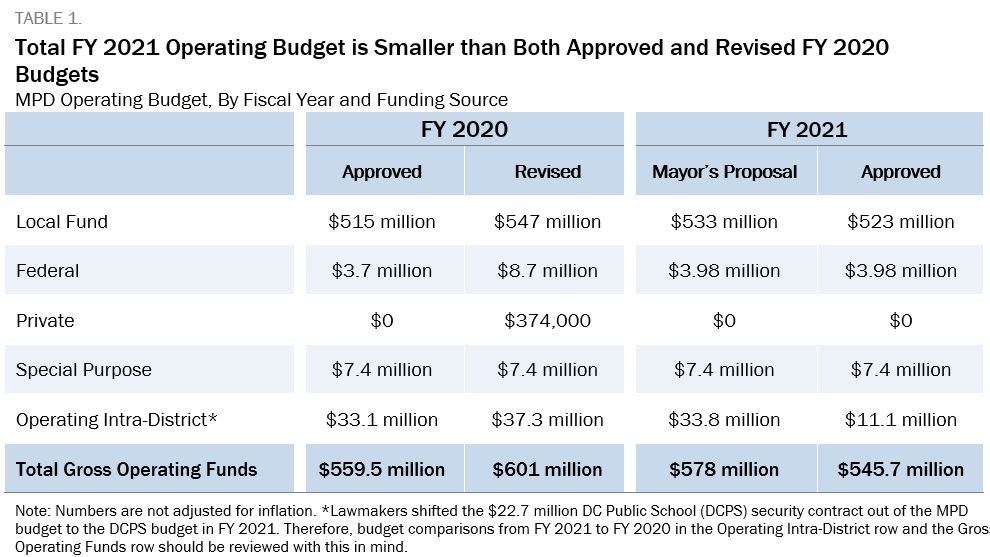
The majority of the MPD budget goes to salaries and benefits, which is common in government spending. The MPD budget is broken down into “personal services,” which includes all salaries and benefits for employees, and “nonpersonal services,” which covers everything else, such as communications, recruitment, etc. For the total gross FY 2021 MPD operating budget, the District allocated $490 million, or 90 percent, for personal services, and $54.9 million, or 10 percent, for nonpersonal services (Table 2).
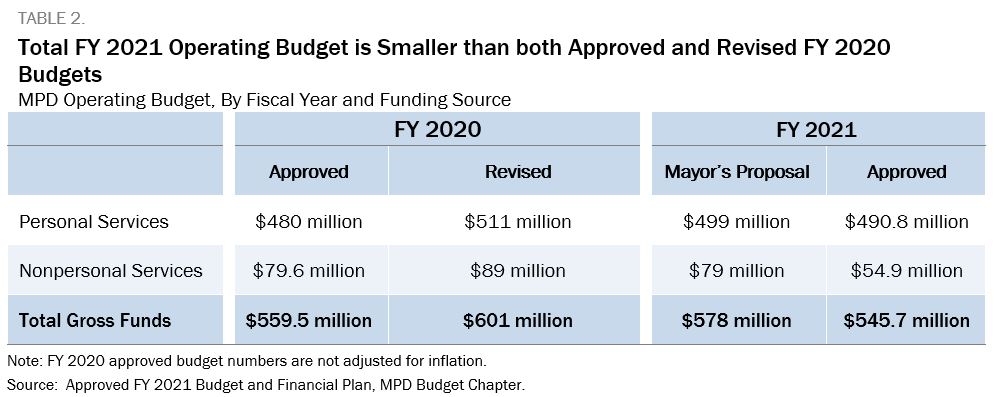
MPD Budget Breakdown by Bureau
The Metropolitan Police Department consists of nine different bureaus. Three of those bureaus—Patrol Services, Investigative Services, and Homeland Security—are responsible for “crime prevention and response services,” domestic security, and intelligence in the District. The Internal Affairs Bureau is the division responsible for investigating “use of force, equal employment opportunity violations, and other misconduct and complaints against MPD employees.”[10] The other six bureaus provide management, administrative, and strategic support for the MPD. More details about each of the bureaus are outlined below (Table 3).
Among all bureaus, the Office of the Chief of Police saw the biggest increase in operating dollars, with a $1.7 million, or 16.4 percent, increase over the FY 2020 approved budget. The Investigative Services Bureau had the largest overall year-over-year reduction, totaling $12.6 million, or 10.9 percent. This reduction reflects the transferring of the school security contract from MPD to DCPS control. Corporate Services and the Professional Development Bureau also saw significant decreases in funding from the FY 2020 to FY 2021 budget, with $4.7 million and $5.5 million in reductions, respectively.
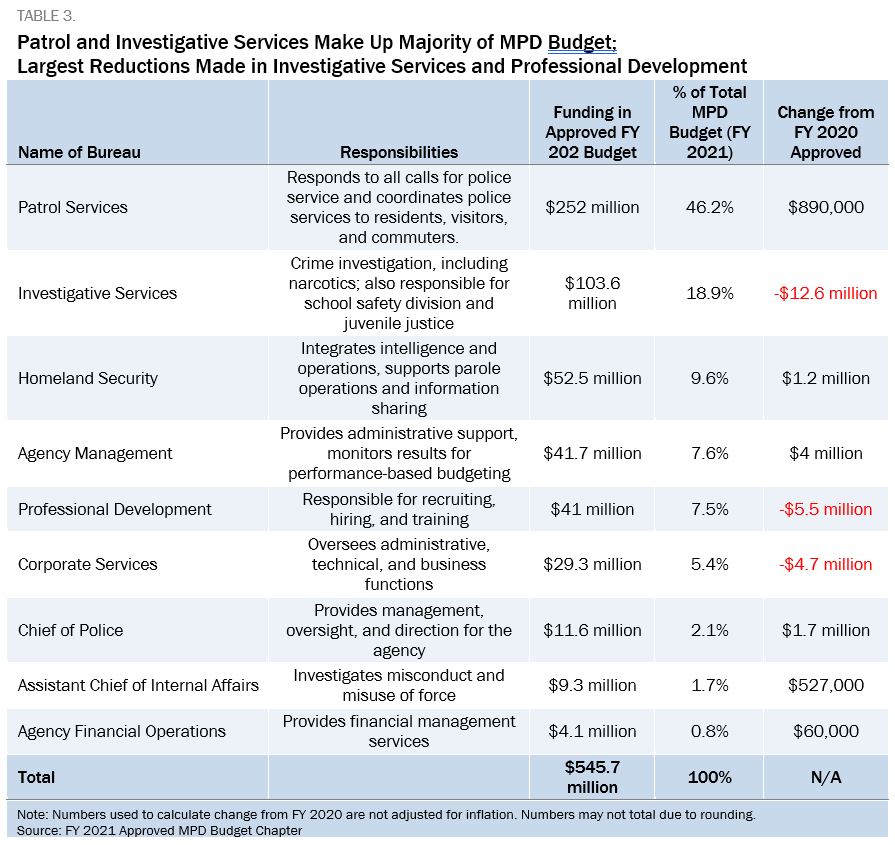
Council Budget Reductions from Mayor’s FY 2021 Budget Proposal
The Mayor proposed allocating $578 million for the total MPD operating budget in FY 2021. The Council modified the Mayor’s proposal by cutting MPD local spending by $9.6 million and shifting management of the $22.7 million school security contract from MPD to DC Public Schools, reducing the total approved operating budget to $545.7 million. The budget cut spending on vacant positions, equipment, travel, among other investments (Table 4).
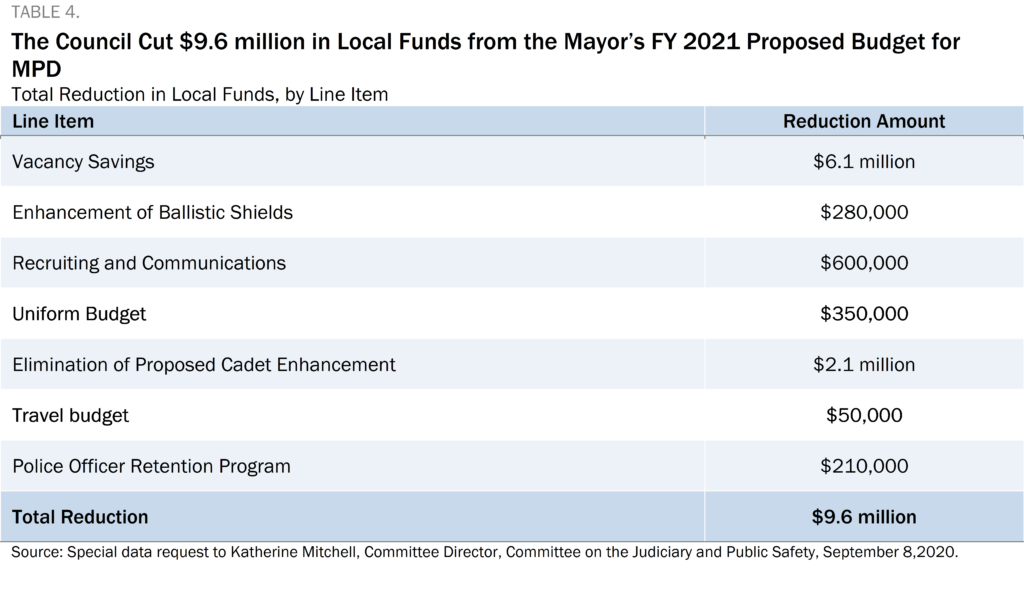
Removal of Enhancement for Cadet Program
Part of the $9.6 million cut targets the MPD Cadet Corps Program, which gives DC high school graduates a scholarship to the University of the District of Columbia and a part-time job as “civilian employees” while they earn college credits and work toward entering the MPD police academy. Mayor Bowser has credited this program with “increasing opportunities for DC residents” and “ensuring that future MPD members are from the District and have a greater understanding of the communities and people that they serve and protect.”[11]
In her proposed FY 2021 budget, Mayor Bowser allocated a nearly $2.1 million enhancement to the Cadet Corps Program, but the Council cut that enhancement in the approved budget. Lawmakers, including in the District, frequently call for and support programs to diversify police forces and hire locally, perhaps hoping to mitigate police brutality against Black communities by creating a police force that looks like the communities they patrol. However, there are many studies showing that the race of an individual officer has almost no effect on their use of force. These studies suggest that diversity within police forces does not outweigh the effects of inadequate accountability measures and a culture that rewards aggressive police behavior.[12]
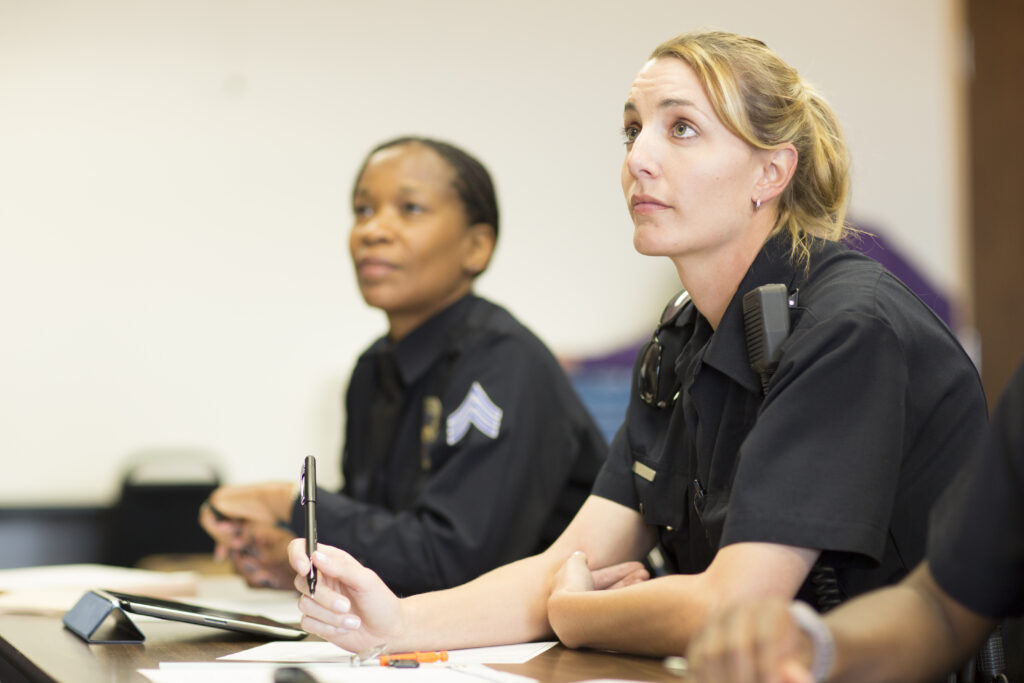
Ending MPD’s Management of DCPS Contract
Historically, MPD had managed the funding for a security contract with DCPS. In previous years, this funding was reflected in the budget as “intra-District funds,” which is a way of tracking payments between District agencies. As a result of community pressure, the DC Council ended MPD’s management of DCPS’s $22.7 million school security contract. The school system will now manage that contract, and that $22.7 million is no longer reflected in MPD’s budget.
The Six-Year Capital Budget
The District implements a four-year financial plan for the General Fund budget and a six-year budget for capital investments. The DC Council cut $3.7 million from the Mayor’s proposed MPD capital budget in FY 2021, leaving the six-year budget at $57.9 million; $16.6 million of that budget is allocated for use in FY 2021. Even with the cut, the six-year budget is $12 million more than what was appropriated in the FY 2020 approved capital budget. The capital budget includes technology, equipment, vehicles, and renovations at MPD facilities.
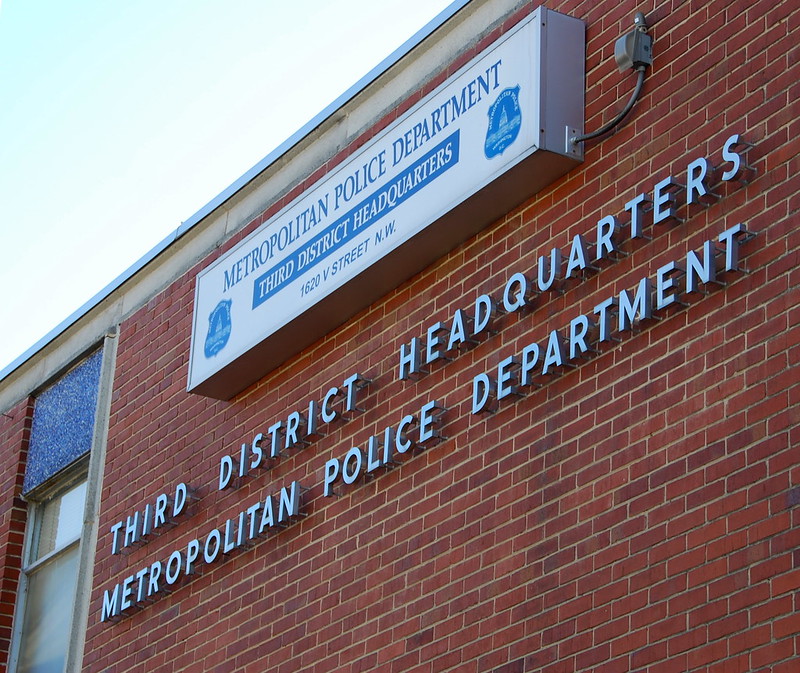
The MPD capital budget includes nearly $5.2 million for technology and equipment to ensure that officers’ cell phones and radios work in government buildings and in dense areas of the District. Additionally, the Mayor’s proposed capital budget included $4 million for LAN and Wireless equipment. The Council cut the appropriation by $1.5 million, leaving this budget at $2.5 million.
The proposed MPD capital budget included nearly $44.6 million for vehicles, including cruisers, unmarked vehicles, motorcycles, scooters, wreckers and trailers. The Council removed nearly $4.9 million, reducing the budget for vehicles to $39.7 million.
The MPD capital budget includes funding for a number of MPD facilities:
- $2.5 million for improvements to the detention areas of the MPD District stations;
- $3 million for a major renovation of the MPD Evidence Impound Lot;
- $2 million for capital improvements to MPD facilities; and,
- $500,000 for feasibility studies for replacements for four District stations.
From these MPD capital cuts, the Council directed $750,000 to the Office of Neighborhood Safety and Engagement (ONSE) to build out its lower floor to accommodate additional Pathways cohorts. The Pathways Program is a transitional employment program offering wrap-around training and support to individuals who are deemed “at risk” of being involved in violent crime.
The Mayor’s proposal for the Department of Corrections capital budget dedicated nearly $35 million for renovations at the DC Jail, including HVAC replacement, emergency power system upgrades, and exterior repairs. The proposed budget also included an additional $13 million for renovations across all 5 Department of Corrections facilities, including the DC Jail. The Council removed $1.25 million from the renovation budgets. Finally, the budget includes $5 million for the design and a feasibility study for a new jail.
The Committee on the Judiciary and the Public Safety redirected $4.25 million of cuts from the cluster’s capital budget to fund recreation centers and $1.25 million to the design of a new fireboat for the District’s waterfront. The Council also redirected $1 million from MPD to fund WiFi improvements in public housing.
Violence Prevention
For many years, advocates, particularly from Black communities, have been pushing for major changes to, if not the complete abolition of, the police. Activist and writer Mariame Kaba wrote recently in her piece for the New York Times, “the only way to diminish police violence is to reduce contact between the public and the police.”[13] In the District, advocates are making similar calls,[14] pushing for a reduction in the police force and for lawmakers to move funding away from police and into alternative community safety programs and other community investments, such as housing and food access. Investments in housing, education, mental health, and food access improve community stability in ways that the police force is not designed to do.
Following the mass mobilizations earlier this year, District lawmakers highlighted the ways in which the FY 2021 budget responded to community demands, including increased funding for violence interruption and community support programs within the ONSE.
Office of Neighborhood Safety and Engagement
ONSE exists both to reduce violence in the District and provide services to DC families experiencing the grief and trauma of violence. ONSE’s mission is to take a public health approach to violence prevention, “recognizing that reducing crime is not accomplished through law enforcement alone.”[15]
The approved FY 2021 budget for ONSE is $10.4 million, a $2.8 million increase over ONSE’s FY 2020 approved budget and a $3.6 million increase over the Mayor’s proposal. The DC Council allocated $403,000[16] for a new program at ONSE, the Restorative Justice Collaborative. This Committee on the Judiciary and Public Safety intends for this program to implement restorative justice practices within the DC government in partnership with community-based organizations. The budget also adds funding for a director of this program and for four “restorative justice fellows.” The Committee intends for these fellows to be returning citizens.
ONSE administers four other programs: The Pathways Program, Family and Survivor Support, the Leadership Academy, and the Violence Intervention Initiative.
- The Pathways Program is a transitional employment program offering wrap-around training and support to individuals who are deemed “at risk” of being involved in violent crime. The District funded the Pathways Program at $1.3 million in FY 2021, almost tripling its funding from the FY 2020 Approved Budget.
- The Violence Intervention Initiative is a collaboration between ONSE and three community-based organizations to engage communities in creating and implementing violence reduction strategies. The District funded this initiative at $6.1 million in FY 2021, up from $4.5 million in FY 2020.
- The Family and Survivor Support program offers support and services to families who have been impacted by a violent incident that involves a minor or if the incident is gang related. Funding for this program decreased slightly in FY 2021 from the FY 2020 Approved budget.
- The ONSE Leadership Academy is a pilot program partnership between ONSE, Anacostia High School, and the Department of Employment Services to offer support to students who are referred to the program because of attendance, behavior, or academic challenges. The FY 2021 budget cut local funding for this program by about 40 percent, reducing it to $592,000. The program will receive $1 million in federal grants that will allow the program to expand to two more schools, according to a statement by Deputy Mayor for Public Safety and Justice Kevin Donahue.[17],[18]
Gun Violence Prevention Initiative
While overall rates of violent crime have dropped in the District, the homicide rate has grown sharply after hitting a 20-year low in 2012.[19] The majority of these homicides are gun-related. Citing the need for an inter-agency strategy for gun-violence prevention, the Council created a new position within the Office of the City Administrator to direct work on gun violence prevention. The District allocated $189,058 in the FY 2021 budget for this initiative.
“Cure the Streets” Violence Interruption Program
The “Cure the Streets” (CTS) program is a violence interruption initiative administered through the District’s Office of the Attorney General. Like ONSE’s Pathways Program, CTS takes a public health approach to violence prevention. CTS hires “violence interrupters” to engage with their communities to help resolve conflicts before they become violent. The program claims to treat violence as “a disease that can be interrupted, treated, and stopped from spreading.”[20]
Originally created as a pilot program, the District funded CTS at almost $7 million in one-time funding in FY 2020. The Mayor’s proposed budget did not renew funding for this program. Many advocates and community members expressed dismay at the major proposed cut to this program. The Council restored the program’s full funding and added a $200,000 enhancement, for a total of $7.2 million.[21] The CTS program receives the vast majority of its funding (up to $7 million) from the Litigation Support Fund, which is funded through revenues that the Office of the Attorney General recovers from settlements on behalf of the District.
Police Reform Commission
The DC Council created the DC Police Reform Commission under the Comprehensive Policing and Justice Reform Emergency Amendment Act of 2020, the District’s emergency police reform legislation passed this summer.[22] The Commission functions out of the Committee of the Whole, which received $500,000 to cover related expenses in the FY 2021 budget. Council Chairman Phil Mendelson appointed the 20 members of the commission, and it has since held two public meetings and called for an independent investigation into the fatal police killing of Deon Kay in August 2020.
[1]Metropolitan Police Department, “FY 2021 Approved Budget Chapter,” August 2020; Metropolitan Police Department, FY “2017 Proposed Budget Chapter,” March 2016.
[2] Bill Meyers, “D.C. Is Teeming With Police Officers, So The Mystery May Be Why Crime Happens At All,” Washington City Paper, September 21, 2017; Governing, “Police Employment, Officers Per Capita Rates for U.S. Cities,” updated July 2, 2018.
[3] IBID
[4]Executive Office of the Mayor, “FY 2020 Proposed Budget Highlights,” Accessed September 14, 2020.
[5]National Public Radio, “The History of Police in Creating Social Order in the U.S.,” June 5, 2020.
[6] Connie Hassett-Walker, “The Racist Roots of American Policing: From Slave Patrols to Traffic Stops,” The Conversation, June 2, 2020.
[7] Michael Harriot, ”A Timeline of Events That Led to the 2020 ‘Fed Up’-rising,“ The Root, May 30, 2020.
[8] For more details on budget basics, including the difference between Operating and Capital budgets, please see “DCFPI’s Resident’s Guide to the DC Budget.”
[9] Special data request to Jen Budoff, Budget Director, Council of the District of Columbia, 17 Sept 2020.
[10]Metropolitan Police Department, “FY 2021 Approved Budget Chapter,” .
[11] Office of the Mayor, “Mayor Bowser Proposes $3.4 Million Investment to Double MPD’s Cadet Program,” February 24, 2020.
[12] Alex S. Vitale, “The End of Policing.” New York: Verso, 2018.
[13] Mariame Kaba, ”Yes, We Mean Literally Abolish the Police,” The New York Times, June 12, 2020.
[14] Stop Police Terror Project, ”Who We Are.” Accessed September 14, 2020.
[15] Office of Neighborhood Safety and Engagement, ”Our Mission & Story,” Accessed September 14, 2020.
[16] Office of Neighborhood Safety and Engagement, “FY 2021 Approved Budget Chapter,” August 2020.
[17] This funding is not reflected in the agency chapter of the published budget books.
[18] Jodie Fleischer, Rick Yarborough, Jeff Piper and Evan Carr, “DC Councilman Vows to Find More Funds for Violence Interrupters Amid Mayor’s Proposed Cuts,” NBC Washington, June 16, 2020.
[19] Maureen Pao, ”How D.C. Is Addressing an Ongoing Spike in Gun Violence,” WAMU, March 2020.
[20] Office of Neighborhood Safety and Engagement “FY 2021 Approved Budget Chapter,” page 3
[21] Special data request to Katherine Mitchell, Committee Director, Committee on the Judiciary and Public Safety, 8 Sept 2020.
[22] Martin Austermuhle, ”D.C. Council Passes Emergency Police-Reform Bill, But Delays Shrinking Size Of MPD,” DCist, June 9, 2020.
